Mellieħa
| Mellieħa Il-Mellieħa | |||
|---|---|---|---|
| Local council | |||
|
Mellieħa as viewed from the sea | |||
| |||
 | |||
| Coordinates: 35°57′23″N 14°21′59″E / 35.95639°N 14.36639°ECoordinates: 35°57′23″N 14°21′59″E / 35.95639°N 14.36639°E | |||
| Country |
| ||
| Region | Northern Region | ||
| District | Northern District | ||
| Borders | Mġarr, St. Paul's Bay | ||
| Government | |||
| • Mayor | John Buttigieg (PL) | ||
| Area | |||
| • Total | 22.6 km2 (8.7 sq mi) | ||
| Elevation | 150 m (490 ft) | ||
| Population (March 2014) | |||
| • Total | 10,087 | ||
| • Density | 450/km2 (1,200/sq mi) | ||
| Demonym(s) | Mellieħi (m), Melliħija (f), Melliħin (pl) | ||
| Time zone | CET (UTC+1) | ||
| • Summer (DST) | CEST (UTC+2) | ||
| Postal code | MLH | ||
| Dialing code | 356 | ||
| ISO 3166 code | MT-30 | ||
| Patron saint | Our Lady of Victories | ||
| Day of festa | 8 September | ||
| Website | Official website | ||
Mellieħa (Maltese: il-Mellieħa [ɪl mɛˈlːɪːħɐ]) is a large village or small town in the Northern Region of Malta. It has a population of 10,087 as of March 2014.[1] Mellieħa is also a tourist resort, popular for its sandy beaches and natural environment.
Etymology
The name Mellieħa is derived from the Semitic root m-l-ħ, which means salt. This is probably derived from the ancient Punic-Roman salt pans which existed at Mellieħa Bay. The site of the salt pans is now occupied by the Għadira Nature Reserve.[2][3]
History
Prehistory to Middle Ages
Mellieħa was first inhabited in around 3000 BC, during the Neolithic. Several megalithic remains have been found, including the temple of Għajn Żejtuna, as well as several caves and tombs, in which tools and pottery fragments were found.[4]
During the Roman period, troglodytes began to live in the caves of Mellieħa's valleys. The cave settlements continued to exist during Byzantine rule, but were abandoned in the early medieval period.
According to the Acts of the Apostles, St. Paul was shipwrecked in Malta in around 60 AD, possibly in the nearby St. Paul's Bay. According to local tradition, St. Luke, who was accompanying St. Paul, came across one of Mellieħa's caves and painted the figure of Our Lady on the rock face. In 409 AD, the cave was consecrated as a church, and it is now known as the Sanctuary of Our Lady of Mellieħa.
Mellieħa was one of the first ten parishes of Malta. It still existed in 1436, but it was abandoned soon afterwards in the late 15th or early 16th century, since the north of Malta was no longer safe due to raids by Muslim corsairs.[5]
Under the Order of Saint John
During the early years of Hospitaller rule in Malta, Mellieħa remained abandoned. In the late 16th century, the Sanctuary of Our Lady of Mellieħa was rebuilt.
The northern coast of Malta began to be fortified in the early 17th century. The first fortification to be built in Mellieħa was Saint Agatha's Tower, which was completed in 1649. This large tower was built on Marfa Ridge, overlooking Mellieħa Bay, with clear views over to Comino and Gozo. The smaller Għajn Ħadid Tower and Armier Tower were also built in the limits of Mellieħa in 1658.[6]
A series of coastal batteries, redoubts and entrenchments were also built in Mellieħa in the 18th century. Several of these still survive, such as Mistra Battery, Vendôme Battery, Wied Musa Battery and Westreme Battery. The Devil's Farmhouse found at Ta' Randa area is an example of Maltese farmhouses built in the 18th century.
British period to present day

Mellieħa as it is today developed while Malta was under British rule. The village became a parish once again in 1844, and began to develop after the British encouraged people to settle in the area by giving leases to the population. The parish church was built in various stages between 1883 and 1930. A postal agency opened in Mellieħa in 1891.[7]
Just before World War II, Fort Campbell was built in Selmun, while Mellieħa Fort was built on top of Mellieħa Hill as a lookout post. The British also built a number of pillboxes around the coastline of Mellieħa, for defensive purposes in case of an Italian or German invasion.
Mellieħa has seen a lot of development since the end of the war. The Mellieħa Local Council was established by the Local Councils Act of 1993.[2]
Geography
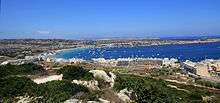
The town of Mellieħa stands on a group of hills on the northwest coast of the main island of Malta. Mellieħa proper consists of the areas of Mellieħa Heights, Santa Maria Estate, il-Qortin, Ta' Pennellu, Ta' Masrija and Tal-Ibraġ. The nearby villages of Manikata and Selmun also fall under Mellieħa's jurisdiction.

The town overlooks Mellieħa Bay, which includes Għadira Bay, the largest sandy beach in Malta. To the east of the town and bay, there is the Selmun peninsula, and St Paul's Islands lie about 80 metres off the coast. Mistra Bay lies close to Selmun, and this marks the boundary between Mellieħa and St. Paul's Bay.[8]
The large Marfa Peninsula lies to the north of Mellieħa. It includes several small bays, such as Armier Bay and Paradise Bay, as well as the harbour of Ċirkewwa, from which the Gozo ferry departs. The Marfa Ridge spans across a large part of the peninsula.
To the south of Marfa Ridge, there are Anchor Bay and Popeye Village, Majjistral Nature and History Park, the hamlet of Manikata and Golden Bay. The boundary with Mġarr lies at Għajn Tuffieħa.
Tourism
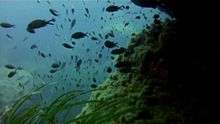
Mellieħa is a popular tourist destination during the summer months. It is well known for its beaches, with the most well known being Għadira Bay and Golden Bay. Ċirkewwa is also popular as a dive site, and it includes the wrecks of MV Rozi and the P29 patrol boat.
In 2009, Mellieħa was awarded the title of European Destination of Excellence due to its sustainable initiatives.[9]
Mellieħa main roads
- Dawret il-Mellieħa (Mellieħa By-Pass)
- Triq Ġorġ Borg Olivier (Ġorġ Borg Olivier Street)
- Triq il-Kbira (Main Street)
- Triq il-Marfa (Marfa Road)
- Triq il-Prajjiet (Anchor Bay Road)
- Triq Louis Wettinger (Louis Wettinger Street)
- Triq San Pawl il-Baħar (St. Paul's Bay Road)
Twin towns
Mellieħa is twinned with the following towns:[10][11]
Gallery
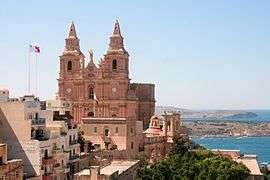 Mellieħa Parish Church
Mellieħa Parish Church
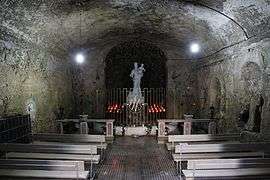 Il-Madonna tal-Għar
Il-Madonna tal-Għar Bars and restaurants
Bars and restaurants- Residential area
- Cliffs with cave dwellings
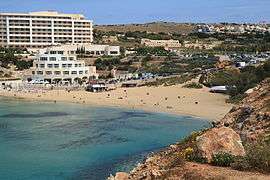 Golden Bay
Golden Bay_02_ies.jpg)
_01_ies.jpg) Majjistral Nature and History Park
Majjistral Nature and History Park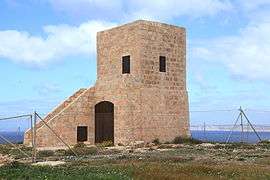
 Anchor Bay and Popeye Village
Anchor Bay and Popeye Village_01_ies.jpg) Ras il-Qammieħ
Ras il-Qammieħ Paradise Bay
Paradise Bay Ċirkewwa Harbour
Ċirkewwa Harbour_01_ies.jpg) Ramla tal-Bir
Ramla tal-Bir


 Għadira Bay
Għadira Bay_01_ies.jpg) Għadira Nature Reserve
Għadira Nature Reserve_01_ies.jpg) Town of Mellieħa
Town of Mellieħa- Selmun coastline
_03_ies.jpg) Għajn Ħadid
Għajn Ħadid- Ruins of Għajn Ħadid Tower
 Ruins of Fort Campbell
Ruins of Fort Campbell


- Mistra Bay
References
- ↑ "Estimated Population by Locality 31st March, 2014". Government of Malta. 16 May 2014. Archived from the original on 21 June 2015.
- 1 2 Muscat, David. "About the village of Mellieha". Mellieha.com. Retrieved 15 May 2015.
- ↑ "Excursions in the Mediterranean". p. 202.
- ↑ Debono, Charles. "Ghajn Zejtuna Prehistoric Temple". Mellieha.com. Retrieved 15 May 2015.
- ↑ Scerri, John. "Mellieha". malta-canada.com. Retrieved 15 May 2015.
- ↑ Mifsud, Simon (24 December 2012). "Għajn Ħadid Tower and Aħrax Tower". MilitaryArchitecture.com. Retrieved 15 May 2015.
- ↑ Proud, Edward B. (1999). The Postal History of Malta. Heathfield: Proud-Bailey Co. Ltd. pp. 273–274. ISBN 1872465315.
- ↑ "Selmun Peninsula". iluvmalta.com. Retrieved 15 May 2015.
- ↑ "Mellieħa and the Hamlet of Manikata (Malta)". European Destinations of Excellence. 1 July 2011. Retrieved 15 May 2015.
- ↑ "Town Twinnings". Mellieħa Local Council. Retrieved 15 May 2015.
- ↑ https://books.google.com.mt/books?id=WMCPAAAAMAAJ&q=mellieha+old+building&dq=mellieha+old+building&hl=en&sa=X&ved=0ahUKEwjzuNGax8jMAhUEthoKHW_uA3UQ6AEIJzAB
External links
| Wikimedia Commons has media related to Mellieħa. |
_02_ies.jpg)


.jpg)